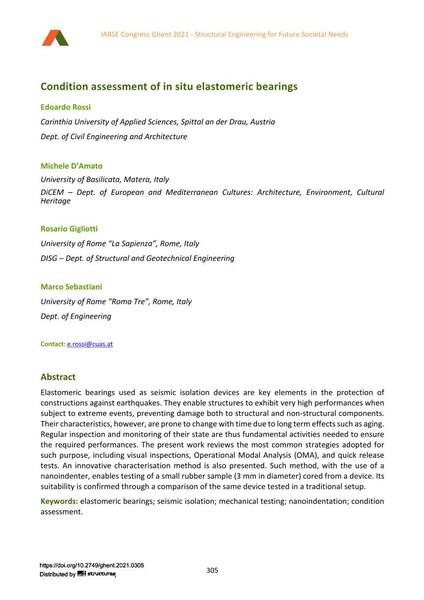Condition assessment of in situ elastomeric bearings

|
|
|||||||||||
Bibliographic Details
| Author(s): |
Edoardo Rossi
(Carinthia University of Applied Sciences, Spittal an der Drau, Austria Dept. of Civil Engineering and Architecture)
Michele D’Amato (University of Basilicata, Matera, Italy; DiCEM – Dept. of European and Mediterranean Cultures: Architecture, Environment, Cultural Heritage) Rosario Gigliotti (University of Rome “La Sapienza”, Rome, Italy; DISG – Dept. of Structural and Geotechnical Engineering) Marco Sebastiani (University of Rome “Roma Tre”, Rome, Italy Dept. of Engineering) |
||||
|---|---|---|---|---|---|
| Medium: | conference paper | ||||
| Language(s): | English | ||||
| Conference: | IABSE Congress: Structural Engineering for Future Societal Needs, Ghent, Belgium, 22-24 September 2021 | ||||
| Published in: | IABSE Congress Ghent 2021 | ||||
|
|||||
| Page(s): | 305-311 | ||||
| Total no. of pages: | 7 | ||||
| DOI: | 10.2749/ghent.2021.0305 | ||||
| Abstract: |
Elastomeric bearings used as seismic isolation devices are key elements in the protection of constructions against earthquakes. They enable structures to exhibit very high performances when subject to extreme events, preventing damage both to structural and non-structural components. Their characteristics, however, are prone to change with time due to long term effects such as aging. Regular inspection and monitoring of their state are thus fundamental activities needed to ensure the required performances. The present work reviews the most common strategies adopted for such purpose, including visual inspections, Operational Modal Analysis (OMA), and quick release tests. An innovative characterisation method is also presented. Such method, with the use of a nanoindenter, enables testing of a small rubber sample (3 mm in diameter) cored from a device. Its suitability is confirmed through a comparison of the same device tested in a traditional setup. |
||||
| Keywords: |
seismic isolation elastomeric bearings condition assessment mechanical testing nanoindentation
|
||||
| Copyright: | © 2021 International Association for Bridge and Structural Engineering (IABSE) | ||||
| License: | This creative work is copyrighted material and may not be used without explicit approval by the author and/or copyright owner. |
||||
